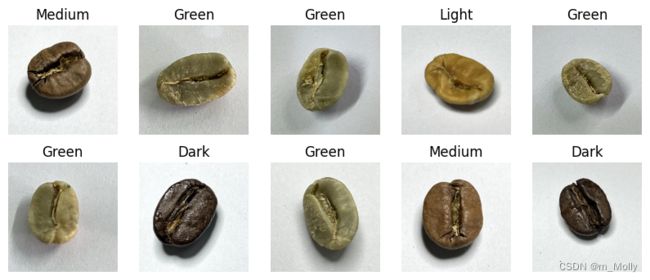Week T7 - 咖啡豆识别(VGG-16)
文章目录
- 1.导入数据
- 2.加载数据
- 3.可视化数据
- 4.配置数据集
- 5. 构建VGG-16网络结构
-
- (1)VGG优缺点分析:
- (2)调用方式:官方模型调用,or 自己写代码搭建
- (3)网络结构:
- 6.训练
-
- (1)设置loss函数、优化器、评估指标
- (2)训练模型
- 7. 可视化结果
- 8.其他尝试
- 本文为365天深度学习训练营 中的学习记录博客
- 参考文章:365天深度学习训练营-第7周:咖啡豆识别(训练营内部成员可读)
- 原作者:K同学啊 | 接辅导、项目定制
- 文章来源:K同学的学习圈子
● 难度:夯实基础⭐⭐
● 语言:Python3、TensorFlow2
要求:
- 自己搭建VGG-16网络框架
- 调用官方的VGG-16网络框架
拔高(可选):
- 验证集准确率达到100%
- 使用PPT画出VGG-16算法框架图(发论文需要这项技能)
探索(难度有点大)
- 在不影响准确率的前提下轻量化模型
○ 目前VGG16的Total params是134,276,932
1.导入数据
from tensorflow import keras
from tensorflow.keras import layers,models
import tensorflow as tf
import numpy as np
import matplotlib.pyplot as plt
import os,PIL,pathlib
data_dir = "D:/jupyter notebook/DL-100-days/datasets/coffebeans-data/"
data_dir = pathlib.Path(data_dir)
image_count = len(list(data_dir.glob('*/*.png')))
print("图片总数为:",image_count)
2.加载数据
关键点:(1)函数image_dataset_from_directory的使用;(2)划分训练集和验证集;
batch_size = 32
img_height = 224
img_width = 224
# 按比例分割训练集
train_ds = tf.keras.preprocessing.image_dataset_from_directory(
data_dir,
validation_split=0.2,
subset="training",
seed=123,
image_size=(img_height, img_width),
batch_size=batch_size)
# 按比例分割验证集
val_ds = tf.keras.preprocessing.image_dataset_from_directory(
data_dir,
validation_split=0.2,
subset="validation",
seed=123,
image_size=(img_height, img_width),
batch_size=batch_size)
# 查看指定数据集的标签名称
class_names = train_ds.class_names
print(class_names)
3.可视化数据
随机显示数据集内的图片,以及查看数据的shape值
plt.figure(figsize=(10, 4)) # 图形的宽为10高为5
for images, labels in train_ds.take(1):
for i in range(10):
ax = plt.subplot(2, 5, i + 1)
plt.imshow(images[i].numpy().astype("uint8"))
plt.title(class_names[labels[i]])
plt.axis("off")
for image_batch, labels_batch in train_ds:
print(image_batch.shape)
print(labels_batch.shape)
break
4.配置数据集
- shuffle() :打乱数据,关于此函数的详细介绍可以参考:https://zhuanlan.zhihu.com/p/42417456
- prefetch() :预取数据,加速运行
- cache() :将数据集缓存到内存当中,加速运行
AUTOTUNE = tf.data.AUTOTUNE
train_ds = train_ds.cache().shuffle(1000).prefetch(buffer_size=AUTOTUNE)
val_ds = val_ds.cache().prefetch(buffer_size=AUTOTUNE)
normalization_layer = layers.experimental.preprocessing.Rescaling(1./255)
train_ds = train_ds.map(lambda x, y: (normalization_layer(x), y))
val_ds = val_ds.map(lambda x, y: (normalization_layer(x), y))
image_batch, labels_batch = next(iter(val_ds))
first_image = image_batch[0]
# 查看归一化后的数据
print(np.min(first_image), np.max(first_image))
5. 构建VGG-16网络结构
(1)VGG优缺点分析:
● VGG优点
VGG的结构非常简洁,整个网络都使用了同样大小的卷积核尺寸(3x3)和最大池化尺寸(2x2)。
● VGG缺点
1)训练时间过长(我发现了,CPU跑太难了),调参难度大。2)需要的存储容量大,不利于部署。例如存储VGG-16权重值文件的大小为500多MB,不利于安装到嵌入式系统中。
(2)调用方式:官方模型调用,or 自己写代码搭建
(3)网络结构:
# 官方模型调用
# model = tf.keras.applications.VGG16(weights='imagenet')
# model.summary()
# 自己写代码搭建
model = models.Sequential([
layers.experimental.preprocessing.Rescaling(1./255, input_shape=(img_height, img_width, 3)),
layers.Conv2D(64, (3, 3), activation='relu', padding='same', input_shape=(img_height, img_width, 3)), # 卷积层1,卷积核3*3
layers.Conv2D(64, (3, 3), activation='relu', padding='same', input_shape=(img_height, img_width, 3)), # 卷积层2,卷积核3*3
layers.MaxPooling2D((2, 2), strides=(2,2)), # 池化层1,2*2采样
layers.Conv2D(128, (3, 3), activation='relu', padding='same'), # 卷积层2,卷积核3*3
layers.Conv2D(128, (3, 3), activation='relu', padding='same'), # 卷积层2,卷积核3*3
layers.MaxPooling2D((2, 2), strides=(2,2)), # 池化层2,2*2采样
layers.Conv2D(256, (3, 3), activation='relu', padding='same'), # 卷积层2,卷积核3*3
layers.Conv2D(256, (3, 3), activation='relu', padding='same'), # 卷积层2,卷积核3*3
layers.Conv2D(256, (3, 3), activation='relu', padding='same'), # 卷积层2,卷积核3*3
layers.MaxPooling2D((2, 2), strides=(2,2)), # 池化层2,2*2采样
layers.Conv2D(512, (3, 3), activation='relu', padding='same'), # 卷积层2,卷积核3*3
layers.Conv2D(512, (3, 3), activation='relu', padding='same'), # 卷积层2,卷积核3*3
layers.Conv2D(512, (3, 3), activation='relu', padding='same'), # 卷积层2,卷积核3*3
layers.MaxPooling2D((2, 2), strides=(2,2)), # 池化层2,2*2采样
layers.Conv2D(512, (3, 3), activation='relu', padding='same'), # 卷积层2,卷积核3*3
layers.Conv2D(512, (3, 3), activation='relu', padding='same'), # 卷积层2,卷积核3*3
layers.Conv2D(512, (3, 3), activation='relu', padding='same'), # 卷积层2,卷积核3*3
layers.MaxPooling2D((2, 2), strides=(2,2)), # 池化层2,2*2采样
layers.Flatten(),
layers.Dense(4096, activation='relu'),
layers.Dense(4096, activation='relu'),
layers.Dense(len(class_names),activation='softmax') # 输出层,输出预期结果
])
model.summary() # 打印网络结构
6.训练
(1)设置loss函数、优化器、评估指标
● 损失函数(loss):用于衡量模型在训练期间的准确率。
● 优化器(optimizer):决定模型如何根据其看到的数据和自身的损失函数进行更新。
● 指标(metrics):用于监控训练和测试步骤。以下示例使用了准确率,即被正确分类的图像的比率。
# 设置初始学习率
initial_learning_rate = 1e-4
lr_schedule = tf.keras.optimizers.schedules.ExponentialDecay(
initial_learning_rate,
decay_steps=30, # 敲黑板!!!这里是指 steps,不是指epochs
decay_rate=0.92, # lr经过一次衰减就会变成 decay_rate*lr
staircase=True)
# 设置优化器
opt = tf.keras.optimizers.Adam(learning_rate=initial_learning_rate)
model.compile(optimizer=opt,
loss=tf.keras.losses.SparseCategoricalCrossentropy(from_logits=True),
metrics=['accuracy'])
(2)训练模型
VGG-16数据量比较大,本来应该用GPU跑的,但是我没有,所以只能用CPU慢慢的跑,大概跑了不到4个小时。训练结果很差。
epochs = 20
history = model.fit(
train_ds,
validation_data=val_ds,
epochs=epochs
)
7. 可视化结果
acc = history.history['accuracy']
val_acc = history.history['val_accuracy']
loss = history.history['loss']
val_loss = history.history['val_loss']
epochs_range = range(epochs)
plt.figure(figsize=(12, 4))
plt.subplot(1, 2, 1)
plt.plot(epochs_range, acc, label='Training Accuracy')
plt.plot(epochs_range, val_acc, label='Validation Accuracy')
plt.legend(loc='lower right')
plt.title('Training and Validation Accuracy')
plt.subplot(1, 2, 2)
plt.plot(epochs_range, loss, label='Training Loss')
plt.plot(epochs_range, val_loss, label='Validation Loss')
plt.legend(loc='upper right')
plt.title('Training and Validation Loss')
plt.show()
8.其他尝试
(1)尝试用之前的课程里的训练方法训练,但是CPU速度跑不过来,跑一个epoch的时间将近45分钟了还没跑完,所以后续有时间跑完了,再来更新。

10.26更新:一整晚开着,早上起来以为泡好了,结果训练到epoch=24时候,突然断开了…但能看到accuracy已经增加到0.97了。所以有空的时候再试试。












